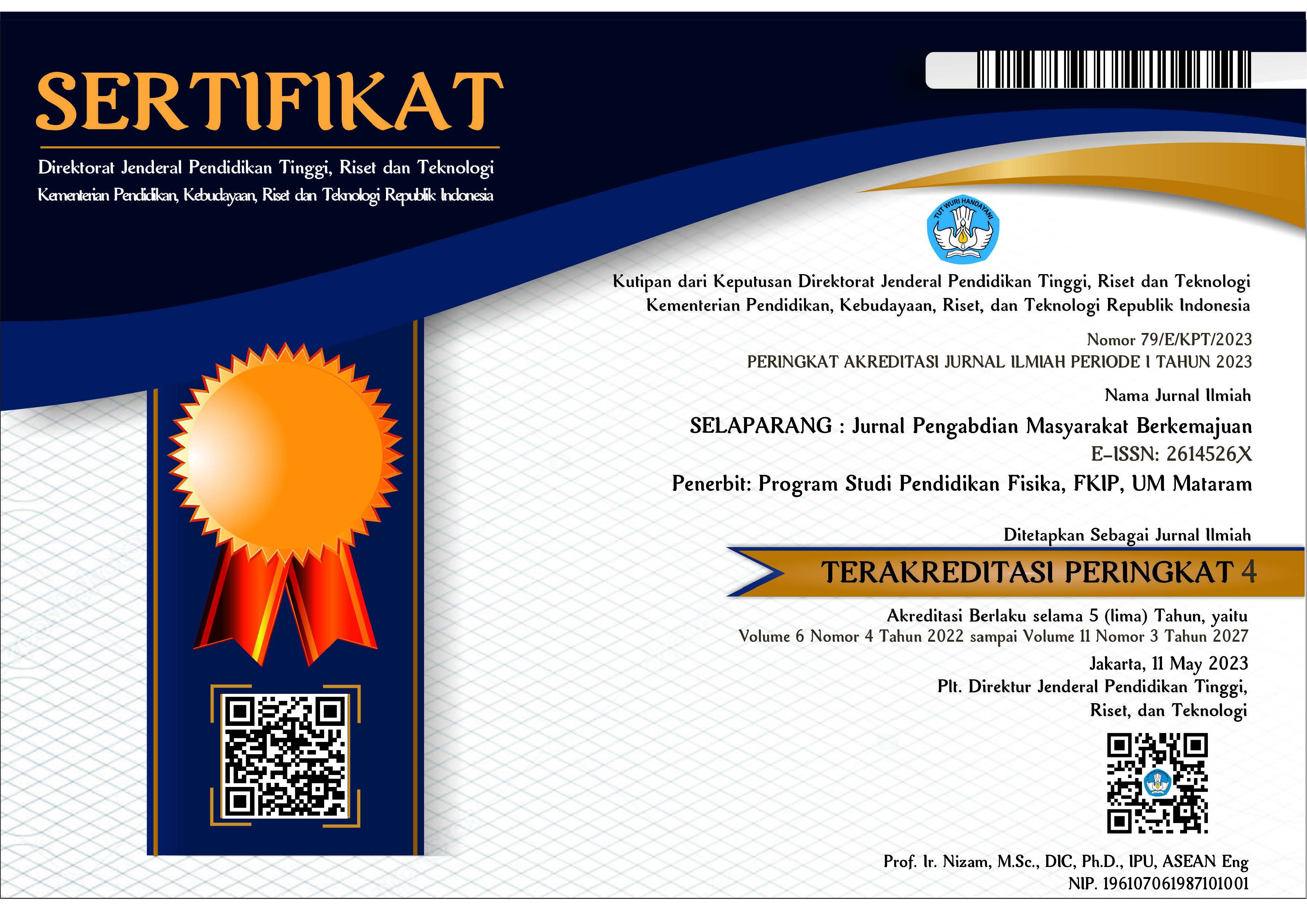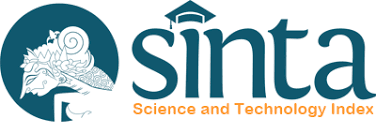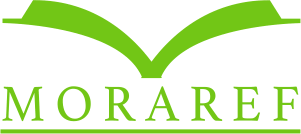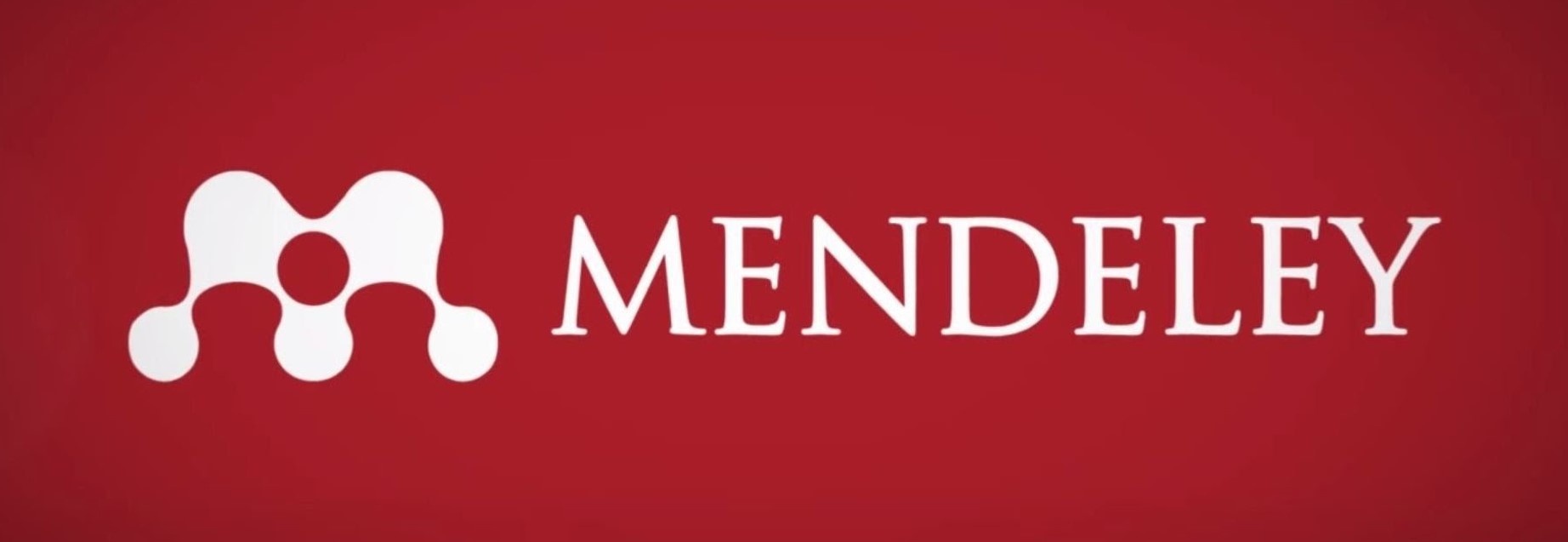Pelatihan inovasi produk berbahan kulit buah manggis sebagai upaya peningkatan perekonomian masyarakat Desa Songgon Kabupaten Banyuwangi
Abstract
Abstrak
Desa Songgon adalah salah satu desa di Kabupaten Banyuwangi yang dikembangkan sebagai desa wisata. Desa ini memiliki kekayaan alam yang melimpah terutama buah manggis sebagai komoditas unggulan. Masyarakat Desa Songgon memanfaatkan buah manggis untuk konsumsi sehari-hari dan dijual. Harga buah manggis di pasaran sangat fluktuatif terutama saat musimnya harganya sangat murah. Permasalahan lain yang dihadapi adalah dari kulit buah manggis yang kerap kali hanya menjadi limbah rumah tangga. Oleh karena itu perlu adanya program peningkatan pengetahuan dan keterampilan terkait pengolahan kulit buah manggis menjadi berbagai produk berdaya jual serta strategi pemasarannya kepada warga Desa Songgon. Metode yang dilakukan berupa penyuluhan dan praktek pembuatan produk kepada kader PKK dan karang taruna Desa Songgon. Hasil dari kegiatan ini adalah meningkatnya pengetahuan peserta dilihat dari kenaikan nilai pre-test 54,9 menjadi 83,9 pada post-test. Peserta juga mendapatkan keterampilan dalam pembuatan teh celup dan sabun antibakteri dengan bahan dasar kulit buah manggis. Hasil uji aktivitas antioksidan dari teh celup mangostana dan mangostana mix yang dibuat menunjukkan bahwa produk teh yang dibuat memiliki aktivitas antioksidan yang baik. Pengetahuan dan keterampilan yang diperoleh kader PKK dan Karang Taruna diharapkan dapat diimplementasikan dalam kehidupan sehari-hari. Peserta belajar bagaimana membuat produk inovatif dari buah manggis sehingga dapat diproduksi secara komersial. Dengan demikian, dalam jangka panjang diharapkan dapat meningkatkan pendapatan masyarakat Desa Songgon.
Kata kunci: Desa Songgon; Banyuwangi; buah manggis; inovasi produk.
Abstract
Songgon Village is one of the villages in Banyuwangi Regency that is developed as a tourist village. This village is rich in natural resources, with mangosteen being one of the most valuable commodities. The people of Songgon Village use mangosteen for daily consumption and for trade. The price of mangosteen on the market is very fluctuating, especially during mangosteen season, it is very cheap. Another issue faced is the mangosteen rind often becomes household waste. The purpose of this community service is to enhance the knowledge and skills of the residents of Songgon Village regarding the processing of mangosteen rind into a variety of innovative health products as well as the marketing strategy of the product. The method used is counseling and practices for PKK cadres and youth organizations of Songgon Village. The results of this program showed that there was an increase in the knowledge of participants according to the pre-test score (54,9) to 83,9 in post-test. Participants also gain the skill in making tea and soap from mangosteen rinds. The antioxidant activity of the tea products, mangostana and mangostana mix, showed good antioxidant activity of the tea infusion. The knowledge and skill gain by participants related innovative products from mangosteen fruit can be implemented, so that they can be produced commercially. Thus, in the long term it is expected to increase the income of the Songgon Village residents.
Keywords: Songgon Village; Banyuwangi; mangosteen; innovative products.
Keywords
Full Text:
PDFReferences
Adimihardja, K., & Hikmat H. (2003). Penilaian Penelitian Partisipatif : dalam Pelaksanaan Pengabdian kepada Masyarakat . Bandung:Humaniora.
Ansori, A. N. M., Fadholly, A., Hayaza, S., Susilo, R. J. K., Inayatillah, B., Winarni, D., & Husen, S. A. (2020). A Review on Medicinal Properties of Mangosteen (Garcinia mangostana L.). Research Journal of Pharmacy and Technology, 13(2), 974–982. https://doi.org/10.5958/0974-360X.2020.00182.1.
Badan Pusat Statistik Kabupaten Banyuwangi. (2019). Kecamatan Songgon dalam Angka 2019. BPS Kabupaten Banyuwangi.
Bi, C., Xu, H., Yu, J., Ding, Z., & Liu, Z. (2023). Botanical Characteristics, Chemical Components, Biological Activity, and Potential Applications of Mangosteen. PeerJ, 11. e15329, https://doi.org/10.7717/peerj.15329.
Chen, S.-P., Lin, S.-R., Chen, T.-H., Ng, H.-S., Yim, H.-S., Leong, M. K., & Weng, C.-F. (2021). Mangosteen Xanthone γ-Mangostin Exerts Lowering Blood Glucose Effect with Potentiating Insulin Sensitivity through the Mediation of AMPK/PPARγ. Biomedicine & Pharmacotherapy, 144, 112333. https://doi.org/10.1016/j.biopha.2021.112333.
Gulcin, İ., & Alwasel, S. H. (2023). DPPH Radical Scavenging Assay. Processes, 11(8), 2248. https://doi.org/10.3390/pr11082248
Hassan, A. A., Moustafa, E. M., EL-Khashab, I. H., & Mansour, S. Z. (2021). Mangosteen Hinders Gamma Radiation-Mediated Oxidative Stress and Liver Injury by Down-Regulating TNF-α/NF-ΚB and Pro-Fibrotic Factor TGF-Β1 Inducing Inflammatory Signaling. Dose-Response, 19(2), 15593258211025190. https://doi.org/10.1177/15593258211025190.
Ihsanpuro, S. I., Gunawan, S., Ibrahim, R., & Aparamarta, H. W. (2022). Extract with High 1,1-Diphenyl-2-Picrylhydrazyl (DPPH) Inhibitory Capability from Pericarp and Seed of Mangosteen (Garcinia mangostana L.) using Microwave-Assisted Extraction (MAE) Two-Phase Solvent Technique. Arabian Journal of Chemistry, 15(12), 104310. https://doi.org/10.1016/j.arabjc.2022.104310
Larasati I. (2015). Aktivitas AntioksidanSirup Kombinasi Ekstrak Kulit Manggis dan Daun Sirsak dengan Penambahan Variasi Konsentrasi Gula Pasir. Universitas Muhammadiyah Surakarta.
MacDonald, C. (2012). Understanding Participatory Action Research: A Qualitative Research Methodology Option. The Canadian Journal of Action Research, 13(2), 34–50. https://doi.org/10.33524/cjar.v13i2.37
Mahmudah, R. , A. I. & S. E. (2020). Efek Farmakologis Garcinia mangostana L. Jurnal Penelitian Farmasi Dan Teknologi , 13(11), 5471–5476.
Matan, N., Kongchoosi, N., Sinthupachee, A., & Chaidech, P. (2024). Nutritional and Bioactive Compound Analysis of Mangosteen Fruit in Hill and Flat Land Plantations, during Both the Season and off-Season, in Provinces along the Gulf of Thailand and the Andaman Sea. NFS Journal, 36, 100182. https://doi.org/10.1016/j.nfs.2024.100182.
Miyamoto, Y., Watanabe, H., Otagiri, M., & Maruyama, T. (2011). New Insight Into the Redox Properties of Uremic Solute Indoxyl Sulfate as a Pro- and Anti-oxidant. Therapeutic Apheresis and Dialysis, 15(2), 129–131. https://doi.org/10.1111/j.1744-9987.2010.00884.x.
Oh, Y., Do, H. T. T., Kim, S., Kim, Y.-M., Chin, Y.-W., & Cho, J. (2020). Memory-Enhancing Effects of Mangosteen Pericarp Water Extract through Antioxidative Neuroprotection and Anti-Apoptotic Action. Antioxidants, 10(1), 34. https://doi.org/10.3390/antiox10010034.
Ovalle-Magallanes, B., Eugenio-Pérez, D., & Pedraza-Chaverri, J. 2017. Medicinal Properties of Mangosteen (Garcinia mangostana L.): A Comprehensive Update. Food and Chemical Toxicology, 109(Pt 1), 102–122. https://doi.org/10.1016/j.fct.2017.08.02.
Pratiwi, Y. S., Rahmawati, R., & Sanjaya, Y. A. (2022). Potency of Mangosteen Pericarp as Source of Antioxidant in Tea to Enhance Immune System: A Review. Proceeding 3rd International Conference Eco-Innovation in Science, Engineering, and Technology, 277–282. http://dx.doi.org/10.11594/nstp.2022.2741.
Rohman, A., Arifah, F. H., Irnawati, Alam, G., Muchtaridi, & Rafi, M. (2020). A Review on Phytochemical Constituents, Role on Metabolic Diseases, and Toxicological Assessments of Underutilized Part of Garcinia mangostana L. Fruit. Journal of Applied Pharmaceutical Science, 10(7), 127–146. https://doi.org/10.7324/JAPS.2020.10716.
Sukatta, U., Takenaka, M., Ono, H., Okadome, H., Sotome, I., Nanayama, K., Thanapase, W., & Isobe, S. (2013). Distribution of Major Xanthones in the Pericarp, Aril, and Yellow Gum of Mangosteen (Garcinia mangostana Linn.) Fruit and Their Contribution to Antioxidative Activity. Bioscience, Biotechnology and Biochemistry, 77(5), 984–987. https://doi.org/10.1271/bbb.120931.
Zhang, L. S., & Davies, S. S. (2016). Microbial Metabolism of Dietary Components to Bioactive Metabolites: Opportunities for New Therapeutic Interventions. Genome Medicine, 8(1), 1–18. https://doi.org/10.1186/s13073-016-0296-x.
DOI: https://doi.org/10.31764/jpmb.v9i2.28952
Refbacks
- There are currently no refbacks.

This work is licensed under a Creative Commons Attribution-ShareAlike 4.0 International License.
______________________________________________________
Jurnal Selaparang
p-ISSN 2614-5251 || e-ISSN 2614-526X
EDITORIAL OFFICE:



















